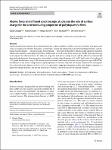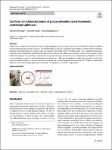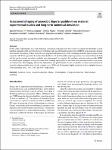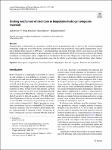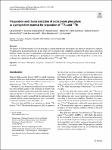Search
Author
- Carlos, Alegría (2)
- Carlos, Seara (2)
- David, Orden (2)
- Klaus, Bretterbauer (2)
- next >
Subject
Date issued
Has File(s)
- true (287)
Search Results
RoboLab enables students to perform real radiochemistry experiments without being physically present in a laboratory. Remotely controlled experiments are accessed through a web interface to a physical laboratory. The laboratory equipment is interfaced to a computer that both controls the equipment and provides feedback to the web user. A generic software template, using a cloud service, was developed to facilitate easy communication between the web browser and the control system. The sixth and most recent RoboLab, aiming at the production and measurement of 234mPa (T1/2 = 1.16 min), has been successfully developed and implemented using this template. |
Antibacterial polymer materials have gained interest due to their capability to inhibit or eradicate biofilms with greater efficiency in comparison with their monomeric counterparts. Among the antimicrobial and anti-biofouling polymers, catecholamine-based polymers — and in particular polydopamine — have been studied due to their favorable adhesion properties, which can be tuned by controlling the pH value. In this study, we used atomic force microscopy (AFM)–based spectroscopy to investigate the relation between the adhesion properties and surface charge density and the pH of electrochemically deposited polydopamine films presenting a dissociation constant of polydopamine of 6.3 ± 0.2 and a point of zero charge of 5.37 ± 0.06. Furthermore, using AFM and attenuated total reflection-... |
The goal of this study is to develop a new effective guar gum-grafted acrylamide hydrogel for wastewater treatment, abbreviated as (guar gum-g-acrylamide). For the non-biodegradable and hazardous synthetic acid red 8, the produced guar gum-g-acrylamide hydrogel is a promising thermally stable adsorbent. Microwave-aided technique, ammonium persulfate initiator, and N,N′-methylene-bis-acrylamide cross-linker are used to make a hydrogel comprising natural polysaccharides guar gum grafted by poly acrylamide. Fourier transformer infrared (FTIR) spectra and scanning electron microscopy (SEM) demonstrate that varied percentages of acrylamide successfully graft the backbone of guar gum. |
Adhesion in an aqueous environment is still a challenging topic. In recent years, the focus on biomimetic adhesives inspired by mussel proteins has greatly increased. The present paper focuses on a straightforward synthesis route for three biomimetic polymers with opportunity in a multi-gram scale and an overall yield of 83% over three steps. Two synthesized monomers combined with commercially available monomers are the basis for three different co-polymers with varying catechol content with nature inspired concentrations. Catechol-bearing monomers were protected prior to polymerization. |
Single particle inductively coupled plasma mass spectrometry (SP-ICP-MS) is a technique widely used to obtain direct information about the number concentration and the size distribution of nanoparticles in liquid suspensions. However, its methods still lack clear quality control strategies to confirm the validity of the information derived from them. Only the detection of the complete size distribution of the nanoparticles in a sample over the size critical value ensures obtaining unbiased quantitative information, otherwise information should be restricted to report the presence of nanoparticles over a certain size and number concentration since their actual total number concentration is underestimated and the size overestimated. |
In this article, we demonstrate the fabrication of thin and macroporous carbon coatings that adhere to various metal substrates such as nickel- or aluminum-based foils or meshes. The coating process is a combination of emulsion-templating and the doctor-blade method, which allows to prepare up to 350 µm thick poly(dicyclopentadiene) membranes with a polyHIPE (polymerized high internal phase emulsions) architecture. Carbonization of these poly(dicyclopentadiene) membranes directly on the metal substrates resulted in up to 30-µm-thick foamy carbon coatings that retain the highly porous architecture and flexibility. Subsequently, carbon foam-coated Ni-foils were filled with elemental sulfur by a melt diffusion technique. |
In this study, experimental tests and numerical simulations (Abaqus) were performed to examine the durability of four impeller materials [steel, polyethylene, polypropylene and glass fiber reinforced polymer (GFRP)] in an anaerobic digester environment. Specimens of these materials were prepared and immersed in a bath containing anaerobic digester liquor while operated at 40 °C for a period of 8 months. Periodically (2, 4, 6 and 8 months) sample specimens were removed from the bath and the tensile strength and elastic modulus were determined. |
Strontium-90 is a radionuclide of concern that is mobile in soil and groundwater and is a threat to life. Activated hydrogel biopolymer composites were fabricated for strontium remediation from groundwater. Batch uptake demonstrated a maximal stontium uptake capacity of 109 mg g−1, much higher than unactivated hydrogel controls. Activation also more than doubled the decontamination factor at environmentally relevant concentrations. EXAFS was used to investigate the binding mechanism, revealing inner sphere complexation of strontium for the first time. Biopolymer composities synthesized for these studies are sustainable and cheap remediation materials that exhibit good strontium uptake and inner sphere binding. |
The interest for ZrP this material is based on its physicochemical properties which makes this material a perspective candidate for applications in nuclear medicine. In this study ZrP was prepared and completely characterized using various analytical methods. Finally, the study of radiometals sorption mechanism on a surface of ZrP and the surface characterization of ZrP were done. In conclusion, ZrP appears as promising for next studies with various purposes like drug delivery system or ion-exchanger for separations of medical radionuclides such as 225Ac and 213Bi. |
Significant amount of effort has been devoted in the development of water electrolysis technology as the prime technology for green hydrogen production. In this paper, we investigate nickel–iron-based electrocatalytic coatings on stainless-steel substrates for commercial alkaline water electrolysers. Stainless steel electrodes for water electrolysis have received attention lately, showing that they can be a low-cost substrate for water electrolysis. Coating stainless steel with low-cost electrocatalysts can prove beneficial to lower overpotential for the oxygen evolution reaction (OER), thereby reducing the overall energy consumption of water electrolysis at an affordable cost. |


